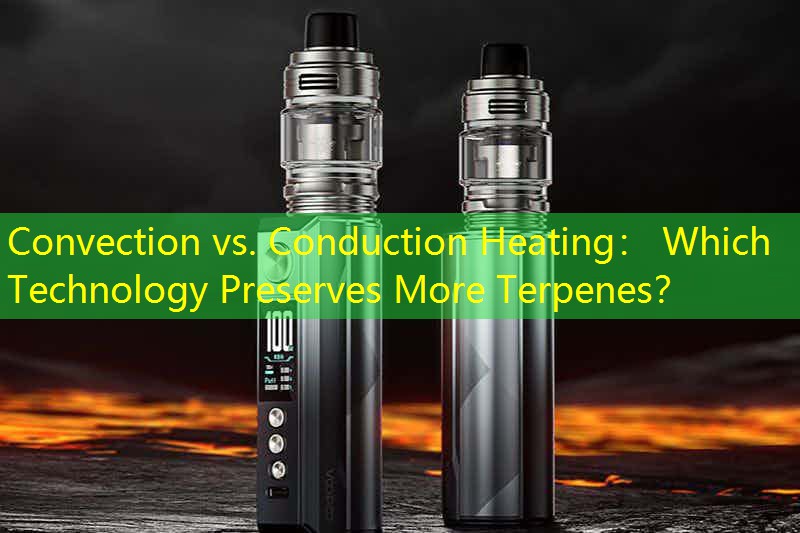Ynlieding
De wrâld fan herbal vaporization is dramatysk evoluearre mei de komst fan ferskate ferwaarming technologyen. Under dizze, konveksje en conduction ferwaarming hawwe krigen wichtige omtinken, benammen oangeande harren fermogen om te behâlden de delikate smaak ferbiningen bekend as terpenes. Dit artikel sil in yngeande blik jaan op konveksje vs. conduction ferwaarming technologyen, evaluearje harren eigenskippen, Meidogger ûnderfiningen, kompetitive fergelikingen, foar- en neidielen, en doelgroep demografy.
Heating Technologies útlein
Convection Heating
Convection ferwaarming brûkt hjitte lucht te ferwaarmjen it krûden materiaal yndirekt, wêrtroch even en krekte temperatuerkontrôle mooglik is. Dizze metoade soarget derfoar dat de aktive ferbiningen, ynklusyf terpenes, wurde ferdampt by optimale temperatueren sûnder it materiaal te ferbaarnen. Brûkers wurdearje konveksje foar syn skjinne en smaaklike damp, dy't de unike profilen fan ferskate stammen behâlde kinne.
Conduction Heating
Yn tsjinstelling, conduction ferwaarming fertrout op direkte kontakt tusken it ferwaarming elemint en it krûden materiaal. Wylst dizze metoade faak flugger is en in robúste dampûnderfining kin leverje, it riskearret oververhitting, potinsjeel degradearjende terpenen en oare flechtige ferbiningen. Brûkers fine oer it algemien kondukteursapparaten gewoaner en faaks minder djoer, mar se kinne offerje smaak yntegriteit foar snelheid.

Produktfunksjes
Sawol konveksje as konduksjevaporizers komme mei in ferskaat oan funksjes, ynklusyf temperatuer kontrôle, portabiliteit, en batterij libben. Konveksjeapparaten hawwe oer it generaal mear avansearre technology dy't krekte temperatueroanpassingen fasilitearret. Yn tsjinstelling, conduction modellen kinne biede ferienfâldige ynterfaces, wêrtroch't se mear brûker-freonlik foar casual brûkers.
Brûkersûnderfining
De brûkersûnderfining ferskilt signifikant tusken de twa technologyen. Konveksjeferwaarming fereasket faak in learkurve om de perfekte tekening en temperatuerynstellingen te behearskjen. Lykwols, brûkers melde dat de payoff is in riker, mear nuansearre smaak. Oarsom, Geleidingsbrûkers wurdearje it gemak fan gebrûk, mar kinne fermindere smaakprofilen fernimme troch unjildich ferwaarming.
Competitive Comparison
Yn it kompetitive lânskip, merken lykas Volcano en Firefly lead yn convection ferwaarming, wylst PAX en G Pen útblinke yn conduction opsjes. Konveksjeapparaten komme typysk op in hegere priis, wjerspegelje harren superieure smaak-behâld kapasiteiten. Dochs, conduction vaporizers faak in berop op budzjet-bewuste konsuminten sykjend ienfâld en gemak.
Foar- en neidielen
Convection Heating Pros
– Superior terpene behâld
– Sels ferwaarming
– Gruttere smaak djipte
Convection Heating Cons
– Hegere kosten
– Mear komplekser te brûken
Conduction Heating Pros
– Snelle opwarmtiid
– Brûkerfreonlik
– Algemien minder djoer
Conduction Heating Cons
– Potinsjeel foar unjildich ferwaarming
– Risiko fan smaakdegradaasje
Doel Brûkersanalyse
Doeldemografy foar konveksjevaporizers omfetsje typysk kenners en yntellektuele brûkers dy't smaak en kwaliteit prioritearje. Dizze persoanen binne faak ree om mear te ynvestearjen yn in premium produkt. Yn tsjinstelling, conduction apparaten tend te lûken mear casual brûkers as dyjingen dy't nij foar herbal vaping, om't se in tagonklik yngongspunt biede sûnder de needsaak foar wiidweidige kennis oer temperatuerkontrôle of ferdampingstechniken.

Konklúzje
Yn gearfetting, de kar tusken konveksje en conduction ferwaarming foar in grut part hinget ôf fan yndividuele foarkarren en prioriteiten. Konveksje jout in superieure ûnderfining foar dyjingen dy't sykje terpenes te behâlden en genietsje fan rike smaken, wylst conduction biedt ienfâld en snelheid foar casual brûkers. It begripen fan dizze ferskillen is krúsjaal foar it meitsjen fan in ynformearre beslút yn 'e dynamyske wrâld fan krûdeferdamping.







